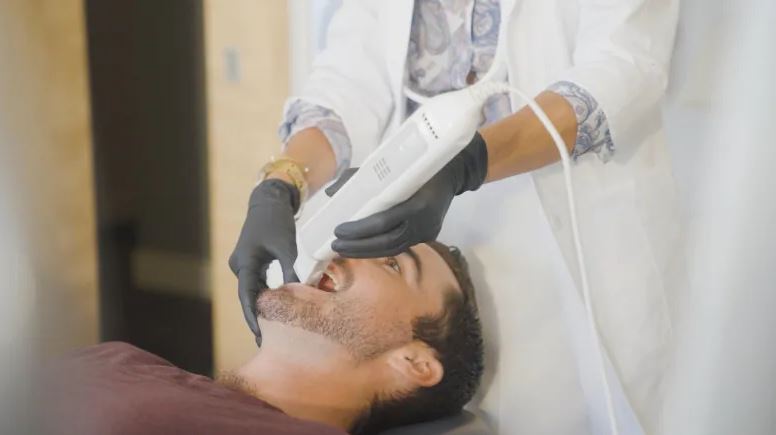Sensory-friendly dentistry helps, but there are still systemic issues, says parent.
It’s by design. When she built her Saint John clinic in 2015, she avoided using materials that create the smell most people encounter when they go to the dentist, and she uses a surgical air cleaner and essential oils to keep things fresh.
Her clinic also has weighted blankets and noise-cancelling headphones. Lights can be turned down, and patients can have music playing or quieter experiences in more private rooms if they want. Bown uses a tell, show, do approach to her work, meaning patients aren’t surprised by any sudden movements or noises.
Bown says she built her clinic this way intuitively, unaware it could be described using a term unknown to her until only a few years ago: sensory-friendly dentistry.
The approach takes into consideration how dental work can be difficult for children and adults who are on the spectrum and struggle with sensory issues.
“We do see and have repeat visits from kids that have perhaps never been able to have a successful visit at a dental office,” Bown said.
Bown’s office, which she recently rebranded under the name Luxe Dental Esthetics, also has chairs that help patients get up and down with ease. She has a device a patient can rest their jaw on if they struggle with keeping their mouth open, and she bought new technology that can diagnose dental decay without using an X-ray machine.

Dr. Peggy Bown graduated from dentistry school in 2001. She learned about sensory-friendly dentistry by herself, and thinks it should become a part of formal education. (Sumitted by Peggy Bown)
Most people think of video games when they hear about virtual reality, but Bown is considering bringing it into her clinic for patients. For now, she asks them where they’d like to travel and plays drone footage of those places on the ceiling while they get dental work done.
To Bown, sensory-friendly dentistry goes beyond fancy equipment to working with patients individually to make them comfortable. Bown had that kind of dentistry when she was 14, an experience so significant it impacted her decision to become a dentist.
She says the “school of life” was the only education she received about sensory-friendly dentistry, but she thinks it should become a part of dentistry training.
Sensory-friendly dentistry can help get kids into the dentist chair and prevent dental decay from happening, Bown said. Otherwise, those patients can end up on long waitlists for surgery.

Lael Osborne’s son Tobiah is non-verbal. He had to wait for more than a year to see a dental surgeon. (Submitted by Lael Osborne)
Lael Osborne is all too familiar with lengthy waitlists.
Her six-year-old son Tobiah is non-verbal. When he can’t sit still in a dentist chair or keep his mouth open, she doesn’t know if it’s because he doesn’t understand or because he’s uncomfortable and afraid.
Tobiah has had multiple abscesses in his mouth, which meant he had to be put on a list to have them surgically removed. Osborne, who lives with her family in Saint John, said dentists who perform these surgeries “don’t really work with autistic kids,” opting to put them to sleep.
But that meant Osborne had to wait for over a year to get her son in for an appointment. During that long wait, she couldn’t tell if he would start acting up due to pain in his mouth or some other reason.
More than two years ago, Tobiah developed a lump in the back of his mouth. At first, Osborne thought it was just a tooth coming in, but as time went by, her concern grew, and Tobiah’s dentist couldn’t provide an answer.
Osborne said for Tobiah’s most recent surgery, she was adamant that the dentists find out what the lump was, especially since his face was starting to occasionally swell up and she didn’t like constantly giving him antibiotics.

Lael Osborne said Dr. Peggy Bown’s sensory-friendly dentistry practices, including weighted blankets and noise-cancelling headphones, would help make her son comfortable, but she wants more systemic changes to happen for kids with special needs. (Submitted by Dr. Peggy Bown)
The problem was that Tobiah wasn’t used to the X-ray machine. Osborne said it took a full year of training just to teach him to brush his teeth. She hoped the same repetition and practice could get him used to the X-ray machine and biting down on the part that goes into a patient’s mouth.
The answer was no, due to billing and insurance reasons, Osborne said. She offered to pay out of pocket, but the answer was still no. She says she was also told he couldn’t be put under for X-rays.
“I was just told repeatedly that there was no possible way to do it, which was extremely aggravating,” she said.
Osborne said the equipment and practices Bown uses in her clinic would make her son more comfortable once he gets to the dentist. She thinks there are more systemic issues to address, though, especially when it comes to how dentists and hospitals work together when the patient is someone with special needs.
“If the right people knew about the problem, it could be fixed. There should be a way to get it done,” she said.
Source: How do people on the spectrum go to the dentist? | CBC News













